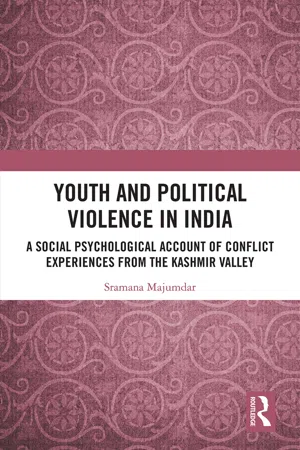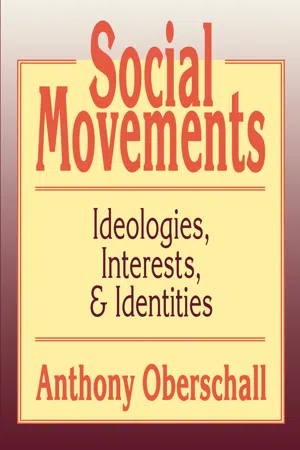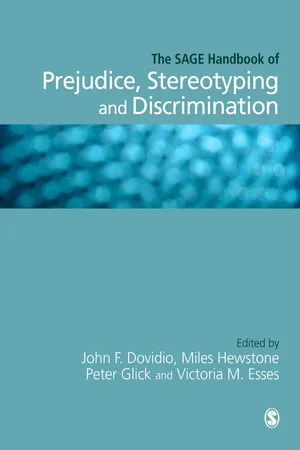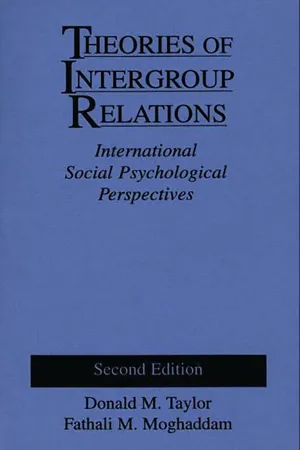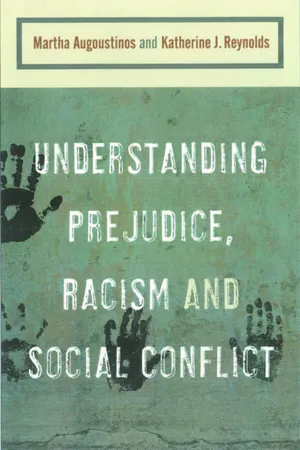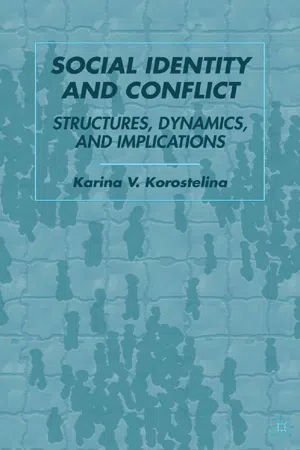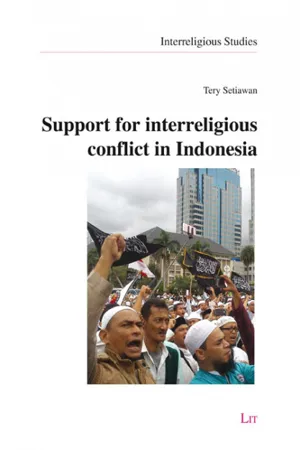Social Sciences
Intergroup Conflict
Intergroup conflict refers to the tension, competition, or hostility that arises between different social groups, such as ethnic, religious, or political groups. This conflict can stem from perceived differences in power, resources, or values, and may lead to discrimination, prejudice, or even violence. Understanding the causes and dynamics of intergroup conflict is a key focus in social sciences for promoting peace and social cohesion.
Written by Perlego with AI-assistance
Related key terms
1 of 5
9 Key excerpts on "Intergroup Conflict"
- eBook - PDF
Conflict at Thessalonica
A Pauline Church and its Neighbours
- Todd D. Still(Author)
- 1999(Publication Date)
- Sheffield Academic Press(Publisher)
I will use the work of Mack and Snyder below when 5. The Social-Scientific Study oflntergroup Conflict 115 to account for this broad range of meaning when defining 'conflict'. For example, Deutsch describes conflict as existing 'whenever incompatible activities occur'. 28 Because this definition is so broad, it is also, at least for our purposes, too blunt. Greater specificity is desired. Other authors such as Louis Kriesburg emphasize the perspectival character of conflict. Kriesburg writes, 'Social conflict is a relationship between two or more parties who (or whose spokesmen) believe they have incompatible goals.' 29 In discussing deviance, the importance of perspective was stressed. I will argue in Chapters 7 and 10 below that incompatible perceptions and goals led to external clashes between Christians and non-Christians. Kriesburg rightly stresses the perspecti-val nature of conflict. It is possible, however, to expand upon and to hone his definition. In his work on group dynamics, D.R. Forsyth observes that the Latin conflictus suggests a 'striking together with force'. 30 Applying the meaning of this word to group interaction, Forsyth suggests that group conflict occurs when 'the actions or beliefs of one or more members of [a] group are unacceptable—and hence are resisted by—one or more of the other group members'. 31 Building upon Kriesberg, Forsyth and others, I offer the following definition of Intergroup Conflict: disputatious social interaction between groups which results from the fact that the behaviors and beliefs of one noting some of the characteristics of Intergroup Conflict. 28. Deutsch, Resolution of Conflict, p. 10. 29. Kriesburg, Social Conflicts, p. 17. See similarly D.G. Pruitt and J.Z. Rubin, who define conflict as 'a perceived divergence of interests or a belief that the par-ties' current aspirations cannot be achieved simultaneously' (Social Conflict: Esca-lation, Stalemate, and Settlement [New York: Random House, 1986], p. 4). - eBook - ePub
Youth and Political Violence in India
A Social Psychological Account of Conflict Experiences from the Kashmir Valley
- Sramana Majumdar(Author)
- 2019(Publication Date)
- Routledge India(Publisher)
1SOCIAL PSYCHOLOGICAL APPROACH TO THE UNDERSTANDING OF CONFLICT
Conflict is a ubiquitous social phenomenon that manifests in various forms, ranging from the interpersonal to conflict within families and small social groups, like kin and neighbourhood, to larger occurrences, like war and regional insurgency. The essential and omnipresent nature of conflict is well described by Berkovitch, Kremenyuk, and Zartman (2009, p. 3), who view it as “an inherent feature of human existence, even useful on certain occasions”. According to the authors, conflict is located at the “very heart of all human societies”, making it a widely explored topic that has intrigued thinkers for generations.When we talk about conflict, it usually refers to opposing stands represented by two or more people or groups. However, conflict may sometimes be between opposing ideas or thoughts of the same person—for instance in a situation that involves taking a stand about an issue or making a decision between conflicting choices. The focus of this book and the research study it describes is on ‘social conflict’ and more specifically Intergroup Conflict. Social conflict is the confrontation of social powers (Rummel, 1976), implying the involvement of more than one person and thus distinct from conflict with or within one self. Tajfel and Turner (1979) differentiate between interpersonal and intergroup behaviour, where interpersonal behaviour is determined by the personal relationships between two individuals and not at all influenced by the social group to which they belong to, whereas intergroup behaviour is completely shaped by group norms and not dependent on the inter-individual relationships. The authors, however, emphasize that in reality social behaviour cannot be segregated along these strict and pure lines as most individuals interact closely with their social environments, merging the lines between the two categories. Rummel (1976) categorizes the manifestations of social conflicts into: - eBook - ePub
Social Movements
Ideologies, Interest, and Identities
- Anthony Oberschall(Author)
- 2017(Publication Date)
- Routledge(Publisher)
“Social” conflict refers to conflict in which the parties are an aggregate of individuals, such as groups, organizations, communities, and crowds, rather than single individuals, as in role conflict. Group conflict is used as a synonym of social conflict in this chapter. Finally, social conflict refers in common usage to interaction in which the means chosen by the parties in pursuit of their goals are likely to inflict damage, harm or injury, but not necessarily in every case. With this small proviso, Coser’s definition of social conflict conveys its meaning very well (1967, 232): “social conflict [is] a struggle over values or claims to status, power, and scarce resources, in which the aims of the conflict groups are not only to gain the desired values, but also to neutralize, injure, or eliminate rivals.” Social conflict encompasses a broad range of social phenomena: class, racial, religious, and communal conflicts; riots, rebellions, revolutions; strikes and civil disorders; marches, demonstrations, protest gatherings, and the like.The Scope of Conflict Theories
Just what do theories of social conflict seek to explain? Any comprehensive theory of social conflict should encompass the following topics:- The structural sources of social conflict, in particular structures of domination that make struggles over values and scarce resources likely. At this stage, a theory of social conflict will rely heavily on stratification, social change, and macrosociological theories. These theories will identify the most important explanatory variables in conflict theories.
- Conflict-group formation and the mobilization for collective action of challenging groups and their targets: for this topic, theories of collective action, recruitment, participation, commitment, and internal structure will be especially useful.
- The dynamics of conflict: processes of interaction between conflict groups; the forms of conflict; its magnitude, scope, and duration; escalation and de-escalation; conflict regulation and resolution; the consequences of conflict outcomes for the contending groups and the larger society. These are the most important dependent variables of social conflict theories.
- John F Dovidio, Miles Hewstone, Peter Glick, Victoria M Esses, John F Dovidio, Miles Hewstone, Peter Glick, Victoria M Esses, SAGE Publications Ltd(Authors)
- 2010(Publication Date)
- SAGE Publications Ltd(Publisher)
14 Intergroup Competition Victoria M. Esses, Lynne M. Jackson, and Caroline Bennett-AbuAyyash ABSTRACT Competition between groups for resources, be they tangible or symbolic in nature, is a fundamental trigger of prejudice and discrimination. Research in this area has shifted from a focus on trying to understand true conflicts of interest between groups to an acknowledgement that perceptions of conflicts of interest are of utmost importance. Recent theory and research in this area can be classified as focusing on more distal, ideological factors versus proximal, situational, an target-relevant factors leading to group conflict. After briefly reviewing the history of research in this area and providing an overview of recent theory and research, we describe the Unified Instrumental Model of Group Conflict that incorporates the variety of factors that have been examined in this context. We then discuss potential fruitful directions for future research, and provide a summary of the state of knowledge in this area. INTERGROUP COMPETITION Group conflict and competition seem to be inevitable features of human social behavior. Though we consider twenty-first century humans to be highly civilized, we have not escaped the tendency to form groups and then compete with other groups over tangible resources, such as land, fossil fuel reserves, and employment opportunities, or over intan-gible, more symbolic resources, such as status, prestige, and religious dominance. Within social psychology, group competition has historically been considered of key importance in understanding prejudice and discrimination, though its presumed role has shifted over time. In this chapter, we provide a brief history of theory and research on the role of group competition in prejudice and discrimination, survey the research in this area, and present our Unified Instrumental Model of Group Conflict that integrates and builds on this literature.- eBook - PDF
- Catherine A. Sanderson, Saba Safdar(Authors)
- 2014(Publication Date)
- Wiley(Publisher)
One might therefore conclude that it is important for minority and majority groups to be informed about these biases to ensure that all individuals have the same opportunity to achieve equal status and power within an organization (Hewstone et al., 2009). Such conditions facilitate harmonious intergroup relations and help make organizations and other groups more effective. SOCIAL IDENTITY THEORY FACTOR EXAMPLE Status of the in-group Anita knew that her university team was not going to make the final cut for the provincial swim team. She hoped that the rival university team, located in the same city, would not make the final cut either. Status within the group Trying to get accepted by his White colleagues, Nasir told some racist jokes about immigrants at lunch. Group size Maili is one of the three female staff out of more than 20 firefighters. She believes her male colleagues tend to exaggerate the difference between men and women in their abilities. [ CONCEPTS IN CONTEXT ] HOW DOES Intergroup Conflict DEVELOP? An important aspect of intergroup relations is the conflict that occurs between groups, or intergroup conflict. In Chapter 12 on aggression, there are several theories that explain aggres- sive behaviour among individuals. Relative deprivation theory is another theory that applies both to individuals and conflict between groups. In this section, we examine realistic conflict theory and relative deprivation theory that attempt to explain intergroup conflict. REALISTIC CONFLICT THEORY One of the causes of group conflict is direct competition for limited resources (Esses, Jackson, & Armstrong, 1998; Jackson, 1993). Realistic conflict theory posits that the ani- mosity between different groups, such as that between Blacks and Whites, men and women, realistic conflict theory – a theory that describes conflict between dif- ferent groups as resulting from individuals’ self-interest motives in competition for jobs, land, power, and other resources - eBook - PDF
Theories of Intergroup Relations
International Social Psychological Perspectives
- Fathali M. Moghaddam, Donald M. Taylor(Authors)
- 1994(Publication Date)
- Praeger(Publisher)
There is a third possible reason for the neglect of intergroup relations as a topic, one that affects not only social psychology but all of the social sciences. Coser (1956) notes that at one of the first meetings of the American Sociological Society, held in 1907, the major topic was social conflict. By 19 social conflict was still a central issue at the annual Social Psychology 5 meetings. By 1950, however, Bernard (1950) was prompted to ask, "Where is the modern sociology of conflict?" A partial answer may be found through an examination of the position of the social scientist in society and how that role has changed. Initially the social scientist was an advocate of change; his or her theory and research were not dependent upon funding from the establishment, be it government or industry. The social scientist was a champion of social reform, change, and the as- sociated conflict. As soon as funding for universities and research emanated from the establishment, interest in social conflict gave way to a focus on social management. Perhaps, then, to a certain extent the piper is calling the tune, and Intergroup Conflict, because it can be a threatening topic from the point of view of the established order, has become less central. The accuracy of this analysis requires validation, of course, but it must be raised here as one possible explanation for the current status of research into intergroup relations. Whatever the reasons, social psychology has not kept pace with sociol- ogy and political science when it comes to making a concentrated and coordinated research effort to understand relations between societal groups. The result is that the research in social psychology has not been integrated, and the disparate direct and indirect strands of thought have not been systematized so as to provide a solid base from which to build. - Martha Augoustinos, Katherine Jane Reynolds, Martha Augoustinos, Katherine Jane Reynolds(Authors)
- 2001(Publication Date)
- SAGE Publications Ltd(Publisher)
12 Realistic Intergroup Conflict: Prejudice, Power, and Protest Michael J. Platow and John A. Hunter In this chapter, we will review an approach to the social psychological study of prejudice and discrimination that has, at its roots, a basis in real, material conflicts of interest between various societal groups. This realistic Intergroup Conflict approach (Campbell, 1965) has, as its starting point, the assumption of the reality of group life and a variety of forms of material competition between groups for needed or desired resources (Sherif, 1966). In this manner, the approach differs from some other explanations outlined in this book by adopting a non-reductionistic approach to prejudice. Prejudice, in the current view, is neither an outcome of intrapsychic properties (e.g., Baumeister et al., 1996; Solomon et al., 1991) or differences in personality between individuals (e.g., Altemeyer, 1998), nor is it an outcome of relations between individuals as individuals (i.e., interpersonal relationships; e.g., Rabbie et al., 1989). It is, instead, an approach that considers the ongoing dynamics between groups as wholes, or between individuals as group members in their quests to satisfy group-based needs and desires. In this manner, the social-psychological analysis of realistic Intergroup Conflict dovetails with analyses in other social sciences (Haralambos, 1980; Levine and Campbell, 1972; McGarry and O’Leary, 1995). Of course, as with any of the ideas presented in the individual chapters of this book, we are under no illusions that the realistic Intergroup Conflict analysis of prejudice and discrimination represents the final and complete explanation (see also Tajfel, 1982a). At the same time, however, we will endeavour to take a stand that will at times be extreme, and push our ideas for the sake of pedagogical and theoretical clarity.- eBook - PDF
Social Identity and Conflict
Structures, Dynamics, and Implications
- K. Korostelina(Author)
- 2007(Publication Date)
- Palgrave Macmillan(Publisher)
P a r t I I I Social Identity and Conflict C h a p t e r 6 The Factors That Influence Conflict Dynamics 6.1. Intergroup Prejudice Cognitive social psychologists suggest that cognitive processes, including cognitive prejudice, underlie the judgments and behaviors not only at per- sonal and interpersonal levels, but also at the intergroup level (Mackie and Hamilton 1993a). In cognitive processes, situations are estimated both in terms of personal and ingroup consequences (Mackie and Hamilton 1993b). Many social psychologists using cognitive approaches in studying relation- ships between majority and minority place emphasis on the processes of stereotypization and prejudice. Intergroup prejudice has been analyzed within frameworks suggested by two theories: the theory of social identity (Tajfel and Turner 1979) and realistic conflict theory (Sherif 1953, 1966). Each theory has different explanations of positive evaluations of ingroups and negative evaluations of outgroups. The theory of social identity suggests that the need to acquire high social status and a positive identity through membership in socially prestigious groups is the basis for the formation of intergroup prejudice (Brown 2000; Huddy and Virtanen 1995; Jackson et al. 1996; Tajfel and Turner, 1979; Taylor et al. 1987; Wright, Taylor, and Moghaddam, 1990). This basic need leads to the formation of positive stereotypes to compensate for the low social status of one’s own ingroup (Lalonde 1992; Mummendey and Otten 1998; Van Knippenberg 1978; Van Knippenberg and Van Oers 1984). The social identity theory describes different ways of achieving a positive social identity (Brown 2000; Tajfel and Turner, 1979): the theory accentuates the impact of status and self-esteem on stereotypes, attitudes and prejudice and provides explanations of a person’s behavior in situations of increasing status through the collective action or intergroup migration. - Tery Setiawan(Author)
- 2020(Publication Date)
- LIT Verlag(Publisher)
Campbell added that their distinction is also between a surface meaning and an underlying reality. This distinction is useful for recent studies to the extent that it helps to point out the difference between manifest or overt conflict behaviour, such as physical fights, and latent or covert conflict behaviour, such as avoiding contacts or supporting for interreligious conflict. As it stands now, distinguishing manifest and latent functions serves as a guide to operate the definition of social attitudes of interests and thus, leads us to appropriate measurements. 2.2 Social identity theory Social identity theory has been vastly studied in Intergroup Conflicts (e.g., Mummendey, Kessler, Klink, & Mielke, 1999; Van Stekelenburg & Klandermans, 2013). In line with realistic conflict theory, Tajfel and Turner (1979) proposed that the development of ingroup identification is a mental phenomenon that is embedded in Intergroup Conflict, including the framework of realistic conflict theory. Realistic conflict theory started from the bedrock assumption, that dominant group members affectively distinguish themselves as group members from other subordinate out-groups. This distinction is linked with presumed traits of both the ingroup and outgroups. The latter proposition has been substantiated by social identity theory (Tajfel and Turner 1979; Tajfel 1981, 1982), according to which individuals have the fundamental need to achieve a positive social identity which induces them to perceive their ingroup as superior to ethnic outgroups. Scholars in this field all agree that Intergroup Conflicts heighten individuals’ identification with their ingroup. This condition is sufficient and also necessary to induce ingroup favouritism and discrimination against an outgroup. In this section, we briefly lay out understandings of social identity theory and the implications in conflict situations.
Index pages curate the most relevant extracts from our library of academic textbooks. They’ve been created using an in-house natural language model (NLM), each adding context and meaning to key research topics.

